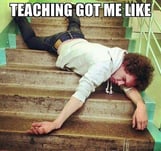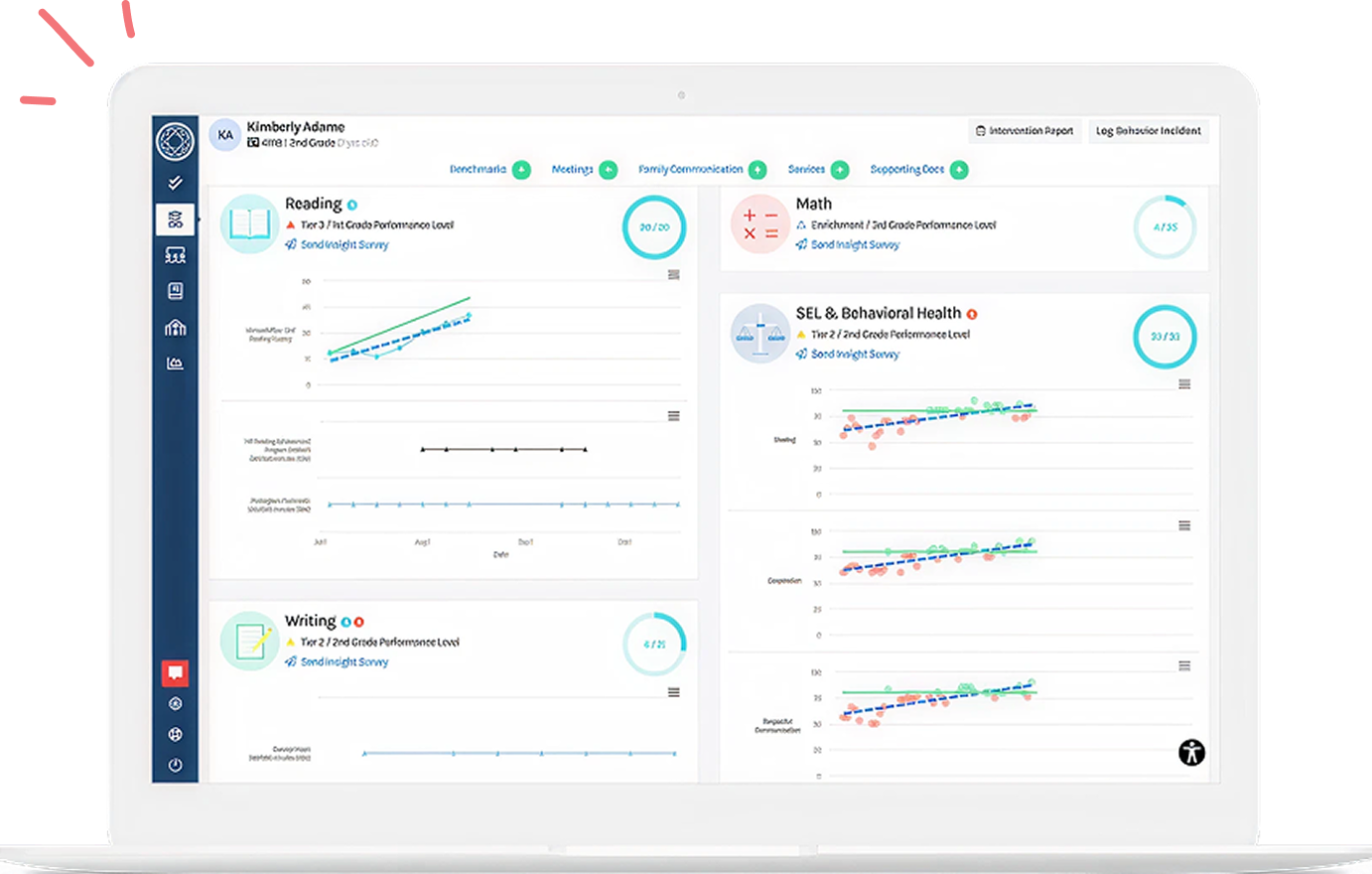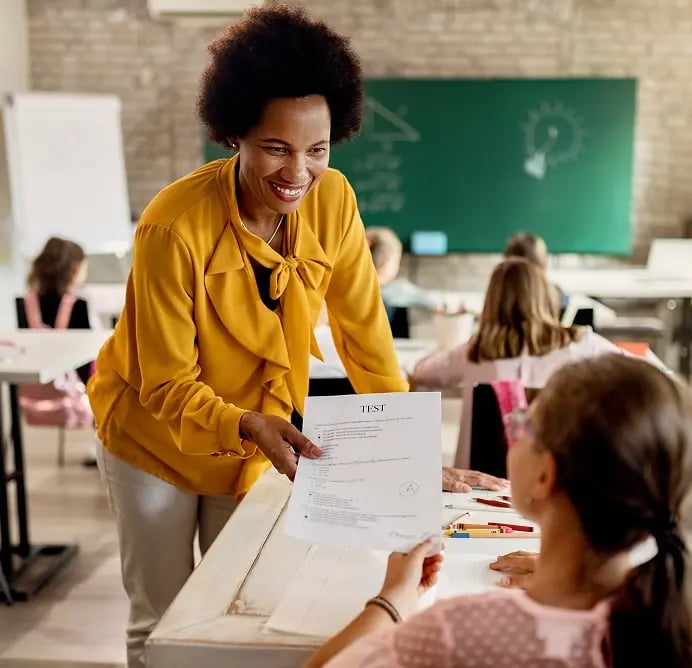 It’s never too late to assess and make changes to the behavior structure and support you offer to your students. Natural breaks in the school year offer an opportunity to reset your approach to behavior and get your classroom or campus back on track. So, let’s talk about how to use the re-entry after a break to move things in the right direction!
It’s never too late to assess and make changes to the behavior structure and support you offer to your students. Natural breaks in the school year offer an opportunity to reset your approach to behavior and get your classroom or campus back on track. So, let’s talk about how to use the re-entry after a break to move things in the right direction!
TIP #1: Reflect and Assess
Intentional reflection is an underrated but vital activity for educators.
- Open a discussion with colleagues about what could be different. There may be pain points at certain times of the day, or transitions that are challenging for students.
|
|
Questions for teacher reflection:
|
- Gather data from students about how things are functioning. An anonymous student survey is a quick way to peek at students’ perceptions of your classroom. Warning…it may be hard to hear some of the feedback. Or, it may be pleasantly surprising. Either way, effective teachers model an open posture to feedback. Making a change or two in response to student feedback shows that their perspectives are taken seriously. Utilize the survey provided here or change it up and add a few questions related to your particular class activities.
|
|
FREE RESOURCE: |
|
Student Survey for reflection on pain points Google Form version |
- For administrators, broaden your reflection to include an analysis of campus-wide behavioral data. Look for patterns. What you can predict, you can often prevent. Are there particular times of day, locations, or activities where behavior issues tend to occur? If so, work with your leadership team to find proactive ways to address these issues. This may mean an increase in supervision or a change in procedures.
The Branching Minds/Safe & Civil Schools webinar and resources linked below can help you and your leadership team assess how schoolwide procedures are working and decide what to prioritize for improvement:
- On-Demand Webinar: Using Proactive and Preventive Behavioral Strategies in MTSS
- Checklist: The Classroom Management STOIC Checklist
- Checklist: The School-wide STOIC Checklist
TIP #2: Build Relationships
Relationships make all the difference in classroom culture. Some students are easy to connect with and are eager to please, while others might be more hesitant to trust adults. Here are a couple of tried and true strategies that help connect with even the most challenging student:
- The “2 x 10" Strategy: spend 2 minutes per day for 10 days in a row talking with the student about anything they want to talk about. A full 2-minute conversation might not be possible at first. Don’t give up. Try for one short, non-work-related, positive interaction a day, and build on that until you’re having a full-fledged conversation regularly.
- Attend a student event to show your support. Make an appearance and spend a few minutes with your students and their families in a different environment. You may gain a whole new perspective, and your students will notice your interest.
Individual relationships with students are important, but building community between students is also important. Consider establishing a routine of connection, such as a classroom circle or morning meeting. This isn’t just for elementary students, either. It can be a powerful way for students of any age to connect with the teacher and with one another.
According to Aperture Education, “These quick, 20-minute sessions strengthen the teacher-student connection; reduce bullying, absences, and behavior incidents; and improve school culture.” When thinking about secondary classrooms, “we have to recognize that we’ll get more out of our students if they feel safe, supported, and known well in our classrooms. The time spent building community will come back to us exponentially in fewer behavior issues and better student engagement.” (Thomas 2018)
Staff members also need time to connect with one another. Administrators can set aside intentional time at faculty meetings or department meetings to check in, share concerns and celebrations, and offer support. Relationship building is universal—the same strategies used for students also work with adults! You can use the same kind of community-building meeting for both staff and students. In fact, it can be helpful to model and experience this sort of meeting with staff before they take it to their own classrooms. Here is a simple meeting format with suggestions you can adapt for your own context.
|
|
|
|
FREE RESOURCE: |
|
TIP #3: Review Expectations and Provide Feedback
Research indicates that students thrive in environments where they know what is expected of them. The beginning of the semester is a great time to review classroom and school-wide expectations and procedures. It seems simple, but reviewing what a class discussion looks like or how a teacher gets the class’s attention can significantly affect student behavior, if there is practice and frequent feedback.
Speaking of feedback, a classroom or campus-wide system that actively encourages teachers to focus on positive behavior and increasing positive interactions can have a big impact on the learning environment and on academic engagement. This can be as simple as greeting students at the door, a format for positive behavior referrals, student shout-outs, or positive parent contacts. Or, you may want to utilize a more formal structure like the Principal 200 to raise attention to expectations and provide positive feedback for a specific period of time or a specific location of the school. If you want better behavior, ensure that students following expectations get plenty of adult attention!
| FREE RESOURCE: | Positive Behavior Referral Template |
TIP #4: Make Space for Fun
When you ask students to talk about teachers they like and respect, it is often those teachers that have fun with students and embed humor into every part of their classroom, whether through jokes, sharing stories, or playing games. Having fun is an essential part of childhood, and moments of humor provide much-needed relief for staff members.
Education is serious business, but the day-to-day work need not be relentlessly serious. Here at Branching Minds, we even have a committee called the “Jolly Branchers,” whose sole purpose is to create opportunities for fun and connection between colleagues. Maybe you have some students or staff members who would love to do something similar!
 A few ideas for fun:
A few ideas for fun:
- Use music, create or find a Spotify playlist to incorporate in the classroom or common areas.
- Share a joke of the day—they laugh at the silly ones, too!
- Play learning games on Fridays or before assessments.
- Celebrate the big and small wins. They are everywhere if we look.
Don’t Forget New Teachers:
If you have new teachers in your building, the return from a break is an excellent opportunity to tweak procedures. For example, a first-year teacher may start the year thinking that they want students to pick up their notebooks from a shelf, but then realizes that the procedure is causing chaos during a transition. After a break is a great time to introduce a new notebook procedure that could make the classroom run smoother. A great resource for new teachers is the book “Your First Year” by Todd, Madeline, and Katherine Whitaker. It provides insight and ideas to help new teachers adjust as they go.
Conclusion
It can be hard not to take behavior challenges personally or become discouraged when learning is disrupted and each day feels like an uphill battle. While there is no silver bullet to fix all behavior problems, using a break to reset can change the trajectory and help create a more positive and uplifting environment for students and staff members.
Key Takeaways:
- It is important to reflect on what is and isn’t working with behavior.
- Relationships have a powerful effect on classroom and school culture.
- Focus attention on the behavior you want more of.
- Some intentional fun can bring students and staff together.
Related resources you may find helpful:
| PBIS: More than Points and Parties | |
| Tier 2 Behavior Intervention Guide | |
| ON-DEMAND WEBINAR: Tier 3 Behavior Planning |
|
|
Interested in Learning How to Support the Whole Child with Branching Minds?Branching Minds makes MTSS easy, efficient, and effective by bringing together all of the components of MTSS so teachers can collaboratively problem-solve and support all students’ holistic needs. Our system-level solution helps schools improve students’ outcomes across academics and behavior. Our platform supports teachers with Behavior and SEL in the following ways: ✅ Assessing SEL Needs with the DESSA
✅ Understand Students Perception of their Own SEL Competence with the SECA ✅ Leveraging SEL Screeners for Tiering ✅ More effective problem-solving ✅ Finding the Right Evidence-based Interventions & Accommodations for Each Learner ✅ Creating Intervention Plans and Monitoring Daily & Weekly Progress in Behavior/SEL ✅ Logging & Monitoring Behavior Incidents ✅ Pattern Matching Behavior Incidents Across Groups
|
|
Citations:
4 Reasons to Start the School Day with Morning Meetings. (2018, March 15). Aperture Education. Retrieved December 1, 2022
Hope, M. (2021, December 17). Avoiding Common Classroom Management Missteps. ASCD. Retrieved November 16, 2022, from https://www.ascd.org/el/articles/avoiding-common-classroom-management-missteps
Thomas, Laura. 2018. “Morning Meetings in Middle and High School.” Edutopia. https://www.edutopia.org/article/morning-meetings-middle-and-high-school/

About the author
Larissa Napolitan & Trudy Bender
Larissa Napolitan is the Content Copywriter for Branching Minds. As a former middle school English teacher and instructional coach, she has over 13 years of experience building systems for improvement, training and coaching teachers in new technology and instructional methods, and leading efforts to build curriculum and literacy initiatives. She holds Masters's degrees in both Curriculum and Instruction and Education Administration from Emporia State University. Not only is she passionate about using her experience and academic knowledge, but loves to use her writing to make a broader impact on education, teachers, and students.
Trudy Bender is the MTSS Marketing Content Manager at Branching Minds. She previously served as the Coordinator of District Behavior Intervention at Waco ISD, where she facilitated the implementation of a multi-tiered system of supports for behavior along with initiatives to improve school climate and to build teacher capacity in classroom management through peer coaching. She is passionate about helping teachers and administrators to develop a positive, restorative, instructional approach to behavior that reduces disproportionality in discipline while improving social-emotional and academic outcomes for all students. Trudy holds an Ed.S. in School Psychology from Baylor University.

Your MTSS Transformation Starts Here
Enhance your MTSS process. Book a Branching Minds demo today.


















.png?width=716&height=522&name=5%20Tips%20for%20De-Escalation%20and%20Building%20Strong%20Relationships%20with%20Students(preview).png)